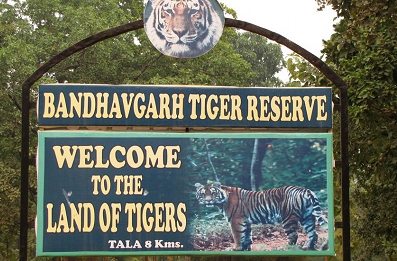Bandhavgarh National Park is in the central Indian state of Madhya Pradesh. This biodiverse park is known for its large population of royal Bengal tigers, especially in the central Tala zone. Other animals include white tigers, leopards and deer. The mix of tropical forest, Sal trees and grassland is home to scores of bird species, including eagles. To the south are the remains of the ancient Bandhavgarh Fort.
The Bandhavgarh Fort is situated in Bandhavgarh in Umaria district of Madhya Pradesh, India. It is located on the Bandhavgarh hill, rising 811 meters above sea level at the centre of the Bandhavgarh National Park. It is surrounded by a large number of smaller hills separated by gently sloping valleys. These valleys end in small, swampy meadows, locally known as ‘bohera’. The fort is also home to many of the endangered species of Vulture in India
Various dynasties have ruled the fort: for example, Mauryans from the 3rd century BC, Vakataka rulers from the 3rd-5th century, Sengars from the 5th century, and the Kalachuris from 10th century. In the 13th century, the Baghels took over, ruling from Bandhavgarh until 1617, when Maharaja Vikramaditya Singh moved his capital to Rewa. The last inhabitants deserted the fort in 1935.
Throughout the tour of Bandhavgarh fort, wildlife such as tigers, cubs, and deer can be seen. In addition, many rare species of birds like Malabar pied hornbill, falcons, 4 species of vultures, and tortoises swimming can also be seen. At some point one can also see vulture nests from above. The hilltop is considered best for photography of flying birds due to the advantage of being positioned at the top. This makes the Bandhavgarh fort a worthwhile addition to a Bandhavgarh National Park wildlife tour.
Bandhavgarh National Park is one of the wild life sanctuaries in the Indian state Madhya Pradesh. The national park is situated at 197 km away north-east of Jabalpur. This wild life park derived its very name from an ancient fort in the area. Bandhawgarh National Park belongs to the Vindhyan mountain ranges of central India and it boasts to have the highest density of tiger population in the country. Now there are about 46 to 52 tigers one can spot here.
The Elusive White Tiger
The forests of Bandhavgarh are the white tiger jungles of the yesteryears. However, no white tigers have been reported from the wild in the last 50 years, and it is believed that less than a dozen have been seen in India in about a hundred years. And yet when white tigers were sighted, it was right here in Bandhavgarh.
Once a hunting reserve of the royal family of Rewa in more recent times, Bandhavgarh was declared a park in 1968. This is also the site where the famous WHITE TIGERS of Rewa were discovered.
Wandering through the Bandhavgarh national park on an Elephant Back, the chances of seeing a tiger are quite good. Among the other wild attractions include, Nilgai, Chausingha, Chital, Chinkara, Wild Boar and sometimes a Fox or Jackal.
In the Bandhavgarh National Park the visitors can be entered on elephant back apart from the four wheelers
